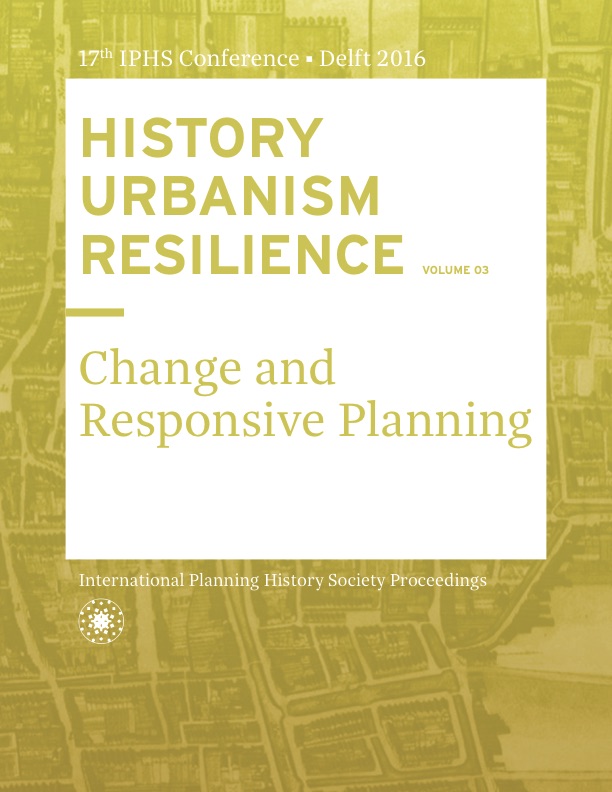Learning From Waterfront Regeneration Projects and Contemporary Design Approaches of European Port Cities
DOI:
https://doi.org/10.7480/iphs.2016.3.1259Abstract
This study analyses the processes and approaches of waterfront regenerations in Europe and examines the factors and actors influencing these processes and aims to evaluate the implementations. Ports have great potentials for transformation of the abandoned industrial heritage for new activities. Throughout the whole world, waterfront regeneration projects are being developed on waterfronts during the last decades. Port cities were always busy due to their trade relations for many centuries. There are some common processes and cross-cultural transactions between port cities, as all port cities have to respond to the same functions to be part of the network. As the functioning ways of transportation and handling were similar, waterfronts of port cities were also designed in a similar way in the 19th and 20th century. Since ports were interrelated and the phenomenon of cross-culturalism existed, architectural approaches and implementations in port cities were transferred to other locations.Port areas changed through expansion of the city, economical changes, technological developments, wars, fires, de-industrialization and containerization. Waterfronts of port cities were shaped and expanded through port needs. Wars and fires demolished the warehouses, but they were rebuilt and the function of the area did not change and port related functions were sustained in the same places. However, facts like containerization and de-industrialization caused the relocation of the port. These vast previously port areas became abandoned and eventually brownfield. These derelict areas are important for the implementation of contemporary architecture. The industrial heritage in these areas has been preserved through regeneration projects, and continuity with the urban pattern has been targeted. Waterfront regeneration projects of port cities are exclusive projects. Waterfront regeneration projects steer our future through past.
By examining some case cities (Docklands, Genoa, Hafencity) we can learn from previous projects realised in last decades, beginning with London Docklands in the European context and reaching today Hamburg Hafencity; the biggest regeneration project in Europe. While this project demonstrates a successful intervention; a relatively failed example from Turkey might be Izmir (Western Turkish waterfront city) waterfront regeneration project. The Hafencity project focused on building quality, sustainability, re-thinking the use of sources, learning through evaluation of previous works.
Like other port cities in the world, the port area of Izmir became a derelict area after de-industrialization. Especially the industrial area behind the port was heavily affected and became vacant. As industrial buildings could not adapt to the changes, they have been abandoned. Only wheat and gas factories are transformed into university and cultural centre.
Although the city of Izmir was affected by fire and war; its cultural memory is a total of different layers of cumulative culture. The failure of the project provides an opportunity to study the role of actors (including architects, planners, organizations, stakeholders) and draw some lessons through previous generations of waterfront regenerations for Izmir. The study mainly aims to suggest some objectives and approaches for the future of the waterfronts of Izmir.
References
Al Naib, S. K. “London Canary Wharf and Docklands. Social, Economic and Environmental.” (2003).
Brian Stewart Hoyle, “The port—City interface: Trends, problems and examples.” Geoforum 20, no. 4 (1989): 429-435.
Carola Hein, “Temporalities of the port, the waterfront and the Port City.” Portus 29 (2015): 1-8.
Christopher C. Letourneur, “Life at the water’s edge: an analysis of human behaviour and urban design of public open space at the water’s edge.” PhD diss., University of British Columbia, 1993.
Dirk Schubert, “Waterfront Revitalisation: From a Local to a Regional Perspective in London, Rotterdam, Hamburg and Barcelona.” Fixity and Flow (2011): 74-100.
Dirk Schubert, “Smart and resilient cities and ports. Perspectives for Hamburg.”, Portus: the online magazine of RETE, n. 29, year XV, Venice, RETE Publisher, ISSN 2282-5789. (2015).
Fatma Tanis, “The Waterfront Regeneration Projects and Contemporary Design Approaches Of European Port Cities.”, MSc. Thesis, (2015).
Han Meyer, “City and Port: Urban Planning as a Cultural Venture in London, Barcelona, New York, and Rotterdam. Changing Relations between Public Urban Space and Large Scale Infrastructure. “ Intl Books, 1999.
Jussi S. Jauhiainen, “Waterfront redevelopment and urban policy: The case of Barcelona, Cardiff and Genoa.” European Planning Studies 3, no. 1 (1995): 3-23.
Jürgen Bruns Berentelg, Presentation of “Learning Cities Platform”, Utrecht, (2012).
Loredana Seassaro, “Quale futuro per Genova. Problemi e processi di trasformazione urbana.” Recuperare 45 (1990): 28-33.
Maria V. Gomez, “Reflective images: the case of urban regeneration in Glasgow and Bilbao.” International journal of urban and regional research 22, no. 1 (1998): 106-121.
Roberto Bobbio, “Complessità di rapporti e iniziative di integrazione fra la città e il porto di Genova.” (2005): 35-41.

